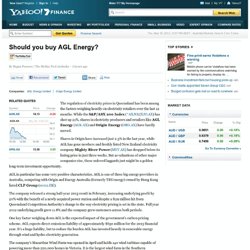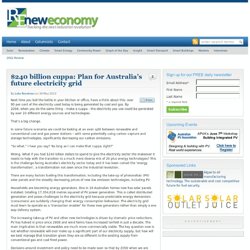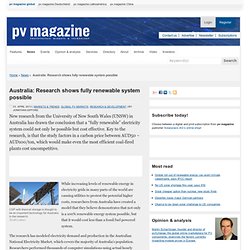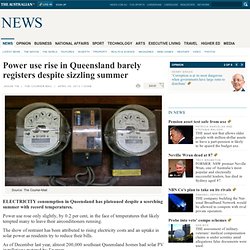

Top 5 developments in electricity in 2012–2013. In this article we give our pick of the top 5 developments in Australia’s electricity sector for 2012–2013. 1.

Power storage breakthrough scores trifecta. Australian Invention Could Revolutionise Solar Energy Storage. 1,000 EVs recharging at once: Coming to a shopping centre near you. What would happen if an Australian shopping centre car park needed to host one thousand EVs all looking for a quick recharge at the same time on a hot summer’s day?

According to a new white paper by NOJA Power, it’s a scenario that could quite easily become a reality in just a few years’ time. And without some major enhancements to Australia’s network capabilities, and its renewable energy capacity, it’s a scenario that could easily enough tip our electricity grid over the edge. Today, EVs only represent a small fraction of Australia’s vehicle fleet – a total of just 253 EVs were sold nationwide during 2012. But according to industry predictions, rising fossil fuel costs and the need to cut greenhouse gas emissions is likely to see this number increase to one million EVs on Australian highways by 2022. NetComm cashes up for M2M assault. NetComm Wireless has raised $5 million from a new share placement, and has flagged substantial new orders in the growing M2M space.

Three weeks ago NetComm was selected by SP AusNet, through its integration partner Ericsson, to supply the 3G communications component for the Victorian Government’s mandatory statewide rollout of smart meters. The company has also landed other M2M deals, but needs working capital to fund the product development these contracts require. NetComm Wireless Chairman Justin Milne said: "We are delighted with the demand we received for this raising both from existing and new shareholders. It is a clear recognition of the potential for success that exists for NetComm Wireless in the global M2M space.
" The placement comprised 19.8 million fully paid ordinary shares at an issue price of $0.255, which represents an 8.9% discount NetComm’s last closing price of $0.280 on 29 May 2013. ChargeIQ EV Charger Could Save You Money by "Talking" to Smart Meters. Preparing for Australia's electricity make-over. In 2050 CSIRO predicts that our homes and businesses could be powered by more than 20 different energy sources and technologies.

Together with its partners CSIRO is helping Australia’s electricity sector prepare for the monumental make-over required to undergo the transformation. CSIRO has just announced a $13 million research collaboration between CSIRO and four Australian universities – University of Sydney, University of Newcastle, University of Queensland and University of New South Wales – to develop the nation’s capacity to plan and design the most efficient, low emission electricity grid for Australia. Launching the Future Grid Cluster, Dr Tom Hatton, CSIRO Energy Group Executive, said the electricity sector is undergoing a huge transformation, a change not seen since the industrial revolution.
“We are facing unprecedented change in the electricity system over the next 20 to 30 years. Analyzing Concentrated Solar Power in Emerging Markets: 2013 Market Report. DUBLIN — Research and Markets ( ) has announced the addition of the "Analyzing Concentrated Solar Power in Emerging Markets" report to their offering.

Market for Concentrated Solar Power in the Emerging Markets of Australia, China, India and South Africa research report is a comprehensive analytical compilation which analyzes the global emerging markets for CSP. Amidst a rapidly changing energy landscape, the concentrated solar power (CSP) sector is battling to secure a foothold as a competitive renewable technology. Confronted with sustained low natural gas prices, increased competition from other renewable technologies, and long development leads times, the pressure has increased significantly for the CSP industry lately.
However, CSP maintains advantages that support recent high profile acquisitions by traditional power players and continued global development activity. Key Topics Covered: A. B. Should you buy AGL Energy? The regulation of electricity prices in Queensland has been among the factors weighing heavily on electricity retailers over the last 12 months.

While the S&P/ASX 200 Index ( ^AXJO ) ( XJO.AX ) has shot up 21%, shares in electricity producers and retailers like AGL Energy ( AGK.AX ) and Origin Energy ( ORG.AX ) have hardly moved. $240 billion cuppa: Plan for Australia's future electricity grid. By Luke Reedman on 30 May 2013 Next time you boil the kettle in your kitchen or office, have a think about this: over 90 per cent of the electricity used today is being generated by coal and gas.

By 2050, when you do the same thing – make a cuppa – the electricity you use could be generated by over 20 different energy sources and technologies. That’s a big change. Greens promise electricity prices to drop under proposed review. Greens Leader Senator Christine Milne speaking at a press conference in Parliament House, Canberra. Picture: Kym Smith Source: News Limited HOUSEHOLD electricity bills would be slashed by around $250 a year under a Greens plan to overhaul Australia's energy system and make it fairer, cheaper and cleaner.
In their first policy for the election campaign, Greens Leader Christine Milne will announce in Melbourne today a plan to create a new federal agency costing $405 million a year they say will drive down power bills with annual savings of $1 billion. The new plan also promises the one million homes with solar panels will get a higher price retailers had to pay them for injecting green power into the network. The Energy Savings Agency would take on power companies to make them better control peak demand costs and manage the over investment in poles and wires, which the Greens say is equivalent to building a 40-lane Sydney Harbour Bridge for just 40 hours of heavy traffic each year. Deregulate NSW energy prices, natioanl energy market report says. General Assembly Should Not Override the Governor’s Veto of Smart Meter Legislation. May 16, 2013 by thesparkspread On May 5, 2013, Illinois Governor Pat Quinn vetoed legislation known as Senate Bill 9 that was pushed by Illinois utilities ComEd and Ameren in response to Illinois Commerce Commission rulings last year.

ComEd says that enactment of SB9 is necessary to get the installation of smart meters back on track. But if SB9 does become law, ComEd has committed to install only 60,000 smart meters in 2013 and another 160,000 in 2014. In stark contrast, over one million smart meters would have been installed by the end of 2014 under the original smart meter installation plan ordered by the ICC.
Smart Grid. Water. Solar. Renewable energy on target for 22% by 2020. By Ric Brazzale on 29 May 2013 The Renewable Energy Target (RET) has come under increasing scrutiny as the level of electricity consumption has fallen. There is confusion over how the RET has been calculated, and particularly in relation to how the initial 20 per cent target has been converted into a fixed target. This Research Note explains in detail how the numbers fit together. 1 Million Residential Solar Power Installations in Australia. Australia: Research shows fully renewable system possible. 03.

April 2013 | Markets & Trends, Global PV markets, Research & Development | By: Jonathan Gifford New research from the University of New South Wales (UNSW) in Australia has drawn the conclusion that a “fully renewable” electricity system could not only be possible but cost effective. Key to the research, is that the study factors in a carbon price between AUD50 – AUD100/ton, which would make even the most efficient coal-fired plants cost uncompetitive. CSP with thermal storage is thought to be an important technology for Australia in the research. Power use rise in Queensland barely registers despite sizzling summer. Source: The Courier-Mail ELECTRICITY consumption in Queensland has plateaued despite a scorching summer with record temperatures.

Power use rose only slightly, by 0.2 per cent, in the face of temperatures that likely tempted many to leave their airconditioners running. The show of restraint has been attributed to rising electricity costs and an uptake in solar power as residents try to reduce their bills. As of December last year, almost 200,000 southeast Queensland homes had solar PV installations metered by Energex. Queensland was still bucking the trend of the rest of the nation, which used an average of 1 per cent less electricity over the same three-month period.
But the Australian Energy Market Operator, which compiled the figures, still observed spikes in use on very hot days - particularly when several occurred in a row. Flooding caused consumption during the 2010/2011 summer to drop by 7.2 per cent to 12,408 GWh. Fully renewable electricity could be competitive. (Phys.org) —A carbon price of between $50 and $100 per tonne of carbon dioxide would make coal-fired and gas-fired power less economical than renewable electricity, a UNSW study shows. Associate Professor Mark Diesendorf, of the Institute of Environmental Studies at UNSW, said all fossil-fuelled power stations in Australia's National Electricity Market could be phased out and replaced economically and reliably with commercially available renewable energy technologies by increasing the carbon price to this "medium" level.
"This carbon price range is considerably less than Treasury estimates for measures that would achieve far less in terms of cutting greenhouse gas emissions," he said. The results of the peer-reviewed study by an interdisciplinary team at UNSW are to be published in the journal Energy Policy. All the technologies, both renewable and fossil, used in the simulations are commercially available now. Rooftop Solar Could Power All Australia Homes (& More) Rooftop Solar Could Supply 134% Of Australian Residential Power Needs.
Rooftop Solar Could Supply 134% Of Australian Residential Power Needs by Energy Matters MEDIA RELEASE 27 March 2013: Australians feeling the pinch from high electricity prices have an economical alternative, and if every suitable rooftop in Australia was turned into a solar power station, the amount of energy generated would supply more than 134.8% of the country's residential electricity needs. Not only would the installation of solar on every roof be a boon for jobs, the cost of the electricity being generated would be reduced to a mere 7 cents per kWh. This potential new pricing point is in total contrast to what Australians are currently paying; up to 40 cents per kilowatt-hour (kWh)1 in some parts of the country, which is predicted to continue climbing. While the total cost of the installation would represent 8% of Australia's yearly GDP, the actual cost would be 0.4% per year as the figure would be amortised over 20 years.
Energy Matters' figures are extremely conservative. Smart Grid Roundup: Silver Spring in Singapore, EnerNOC’s Wireless Mesh.
Installed Base of ZigBee-Enabled Smart Energy Devices to Surpass 219 Million Units Worldwide by 2020, Forecasts Navigant Research. Voltage optimisation reduces power use. Economics. Energy retailer flags $5m loss. Power prices: Beating the peak without punishing the poor. Australia’s electricity prices are rising and not everyone is finding it easy to keep up. Fingers have been pointed at peak demand; the times, like very hot summer afternoons, when we use large amounts of electricity. Building infrastructure to meet that demand is expensive, and that cost gets passed on to consumers. Rising energy costs affect all households and businesses, but some are more vulnerable than others. Low-income families, older people and those with disabilities are particularly at risk. Why AGL is underperforming. Gas and electricity supplier AGL Energy (ASX: AGK) is a well-known and widely owned stock that controls a number of strategic energy production assets and has an entrenched position in the retail market.
Despite this, AGL’s business is facing certain headwinds that have just forced management to lower profit guidance for full-year 2013. To understand exactly why AGL is underperforming requires gaining a deep understanding of the intricacies of energy pricing and the supply and demand dynamics of the domestic energy industry. So while there are a lot of factors at play, the direct explanation for the drop in underlying net profit after tax “to be in the lower half of the guidance range of $590 million to $640 million” was increased retail competition, coupled with soft wholesale prices and higher costs.
AGL stated that the increased retail competition has led to unprecedented customer churn rates. AGL switches off interest in power assets.